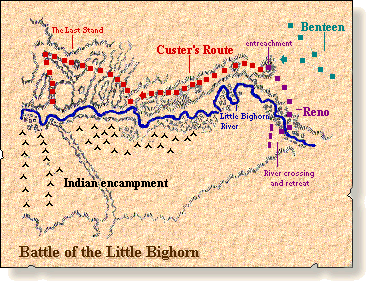George Herendon served as a scout for the Seventh Cavalry - a civilian under contract with the army and attached to Major Reno's command. Herendon charged across the Little Bighorn River with Reno as the soldiers met an overwhelming force of Sioux streaming from their encampment. After the battle, Herendon told his story to a reporter from the New York Herald:
"Reno took a steady gallop down the creek bottom three miles where it emptied into the Little Horn, and found a natural ford across the Little Horn River. He started to cross, when the scouts came back and called out to him to hold on, that the Sioux were coming in large numbers to meet him. He crossed over, however, formed his companies on the prairie in line of battle, and moved forward at a trot but soon took a gallop.
"The Valley was about three fourth of a mile wide, on the left a line of low, round hills, and on the right the river bottom covered with a growth of cottonwood trees and bushes. After scattering shots were fired from the hills and a few from the river bottom and Reno's skirmishers returned the shots.
"He advanced about a mile from the ford to a line of timber on the right and dismounted his men to fight on foot. The horses were sent into the timber, and the men forward on the prairie and advanced toward the Indians. The Indians, mounted on ponies, came across the prairie and opened a heavy fire on the soldiers. After skirmishing for a few minutes Reno fell back to his horses in the timber. The Indians moved to his left and rear, evidently with the intention of cutting him off from the ford.
"Reno ordered his men to mount and move through the timber, but as his men got into the saddle the Sioux, who had advanced in the timber, fired at close range and killed one soldier. Colonel Reno then commanded the men to dismount, and they did so, but he soon ordered them to mount again, and moved out on to the open prairie."
Origin
This first-hand account of the battle was recorded and published by a news reporter from New York Herald. The name of this reporter is unknown, as well as the date when this document was recoreded and published. The original version of the story was from George Herendon, a witness of the Battle of the Little Bighorn. This document is now on EyeWitness To The History.com.
Purpose
The document exist as a record of actual event. It is a record of a first-hand account of the Battle of the Little Bighorn, recorded by a unknown reporter from the New York Herald. This article was intended for the public to know about the reality of the Battle. The provider of this first-hand account is George Herendon, a witness of the battle. The format of this article is written as an oral description from George Herendon, with Herendon speaking and the reporter recording.
Value
The author, George Herendon, was with the 7th Calvary Regiment. George Herendon was under Major Reno's control and goes with his company. The place is at the Little Bighorn River where the Battle of the Little Bighorn took place. The time period is set at 1876, which is the year when the Battle occured, which is also during the Indian-American War. The author, Goerge Herendon, was describing this event through oral description. Herendon was telling the actual event through the perspective of the American side.
Limitation
What we can learn about the battle from this document is not complete. This document is part of the many recorded documents about the battle. From this document, we can only see part of the battle, probably the start of the battle. We cannot see the result of the battle because this document stop at the middle of the battle. Also, we can learn from author's description that the number of Indian was far greater than the American, but approximately how many was not address, probably the number is unknown for the author.







